-
Car Reviews
- All reviews
- Midsize SUVs
- Small cars
- Utes
- Small SUVs
- Large SUVs
- Large cars
- Sports SUVs
- Sports cars
- Vans
Latest reviews
- Car News
-
Car Comparisons
Latest comparisons
- Chasing Deals
Mazda delivers another seven-seat SUV, so is this CX-80 the more affordable large SUV the brand needs to properly challenge the greats?
Trust me, this Mazda CX-80 is an all-new model.
Reckon you’ve seen it before? Nope, that was a different CX-badged SUV. Perhaps it’s my failing eyesight, but Mazda’s fresh Large Product platform SUVs look very much like identical quadruplets. It’s an attractive foursome, but dammit they’re not easy to tell apart.
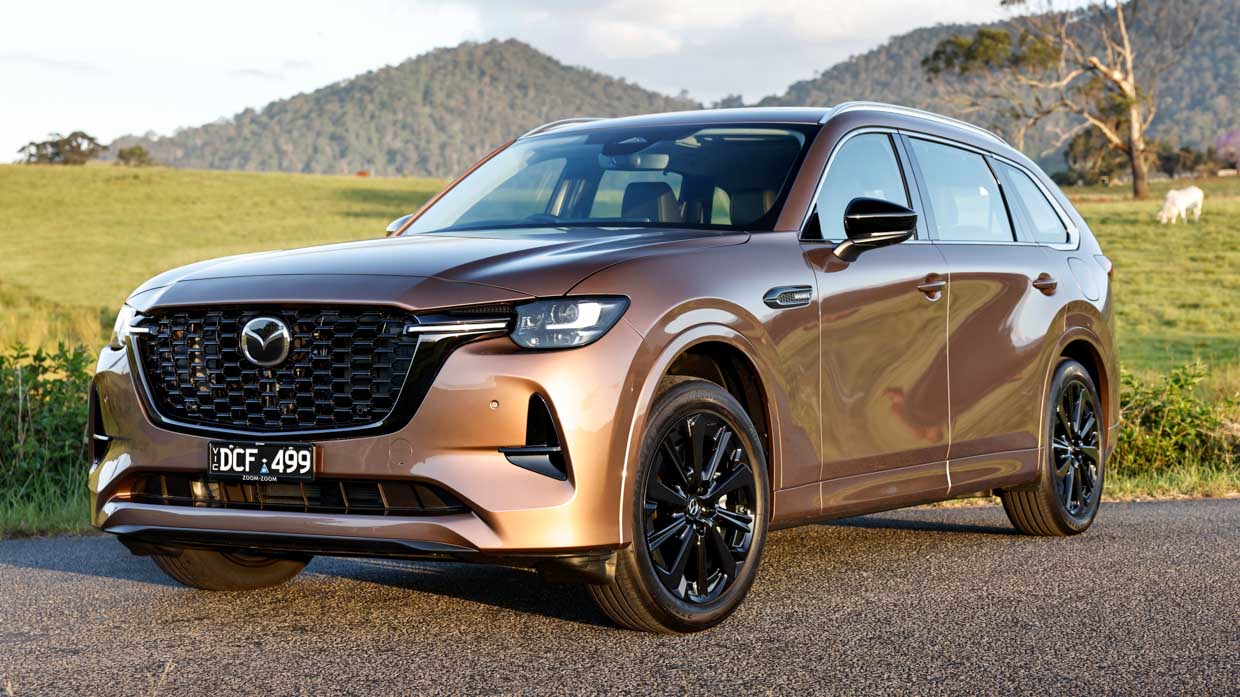
Pictured: the CX-80 GT
We’re the only global market to get all four: the CX-60 medium SUV; then the CX-70, CX-80 and CX-90 large ones. Those first two have five seats; the latter duo boast seven. All have a choice of 3.3-litre straight-six turbo-petrol or turbo-diesel, while the CX-60 and this CX-80 can be bought as plug-in hybrids too.
Confused? You’re not the only one. Think how the poor customer feels, walking into today’s Mazda showroom with a very different SUV line-up to this time last year. Gone are the much-loved CX-8 and CX-9 nameplates, now we’re deep into “Mazda Premium” world and all this fresh, rather homogenised metal.
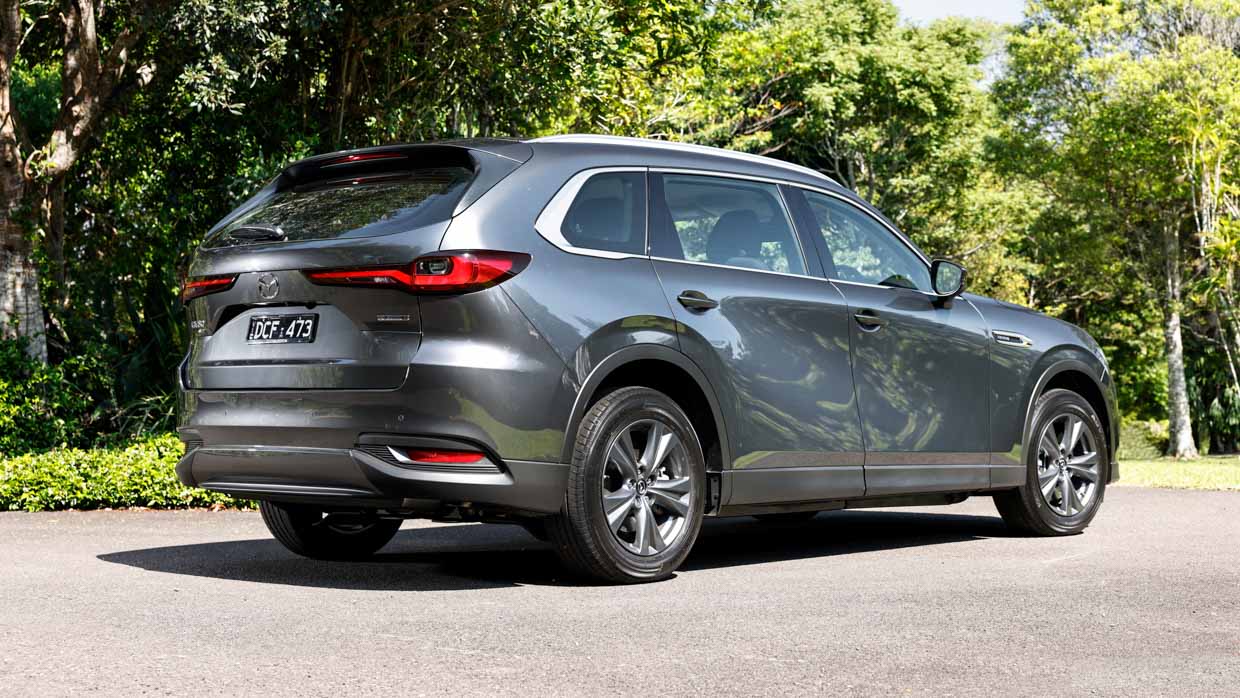
Pictured: the CX-80 Pure
So what’s this new CX-80 all about? Why bother when the CX-90’s already a big seven-seater offered in diesel and petrol, and only arrived last year?
It’s about price. The CX-90 costs from $74,550 and comes in sumptuous trims only, but this CX-80’s a smidge smaller and doesn’t shout premiumness quite so much.
It starts from $54,950 (before on-roads), as Mazda’s offering a Pure grade with cloth seats and small wheels (18-inch) to reel in less well-heeled three-row SUV shoppers. Okay, it’s a chunk more than the old CX-8 (from $42,810) or CX-9 (from $47,600) it’s replacing, but its size, specification, performance and economy improvements justify the jump.
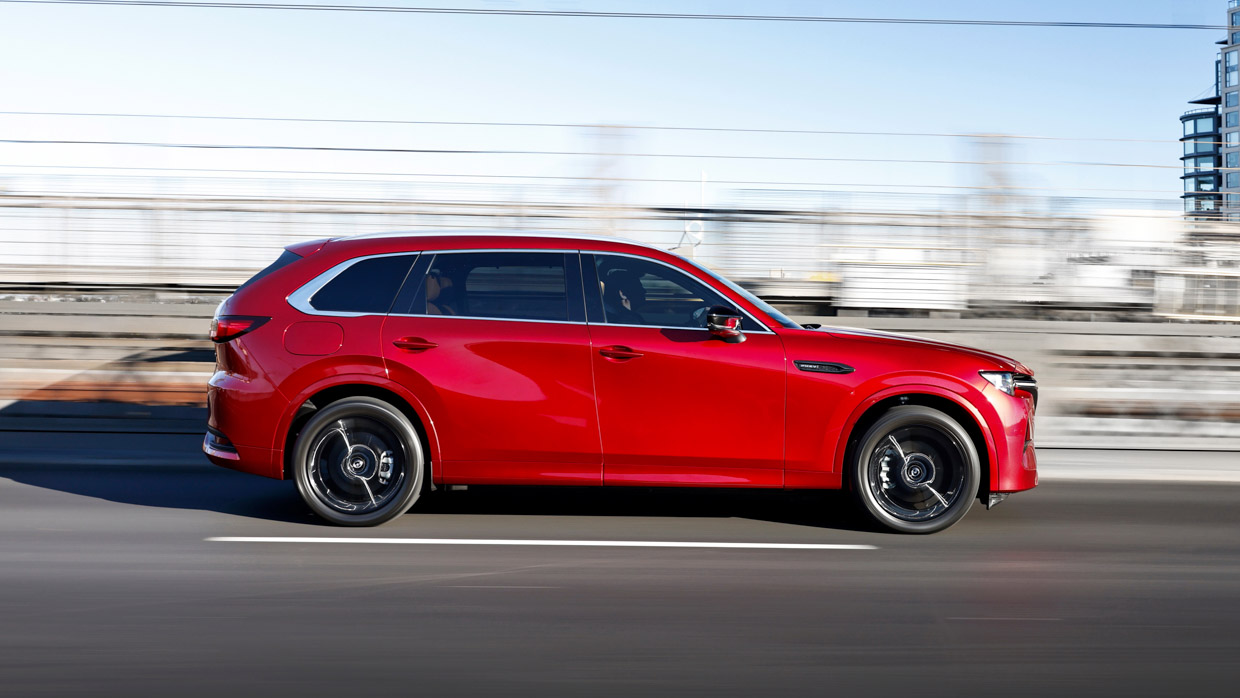
Pictured: the CX-80 Asami PHEV
From a sales perspective, it’s much needed. The CX-90’s price distances itself from seven-seat rivals like the Hyundai Santa Fe, Kia Sorento and Toyota Kluger – the latter two outselling the Mazda by ten-to-one this year.
A CX-80 is, at 4990mm, 130mm shorter than a CX-90, but shares its lengthy 3120mm wheelbase. That trumps a Toyota LandCruiser 300 or BMW X7, so rest assured this Mazda’s a spacious big rig to travel inside, plus boot room’s large and versatile.
After a day testing the petrol, diesel and plug-in versions, it’s clear this is absolutely the big SUV Mazda needs right now.

Kit’s good from entry-level and things get properly luxe when you hit the range’s upper echelons. They’ve gone big on safety, there’s solid build quality, classy interiors, and the long selection of grades and powertrains gives buyers the luxury of choice.
Positively, the CX-80’s overall drive is an improvement over the perplexingly sub-par CX-60 medium SUV Mazda launched last year. It was roundly criticised for an unsettled ride and jerky gearbox, feeling very much an unfinished product. The CX-80’s not perfect on the drive front, but it’s a lot better.
Before getting into that, interested parties must choose which grade and engine best suit their needs and budget.
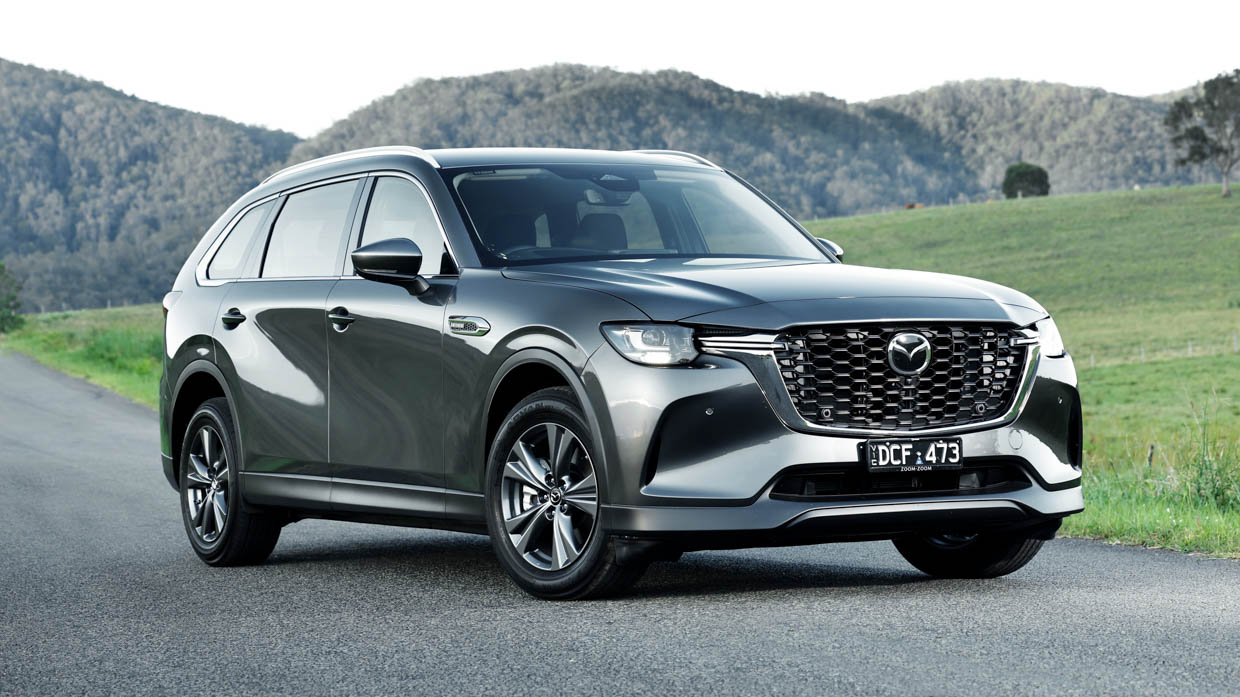
Entry-level Pure comes only with the 209kW/450Nm straight-six turbo petrol. This grade looks woefully under-wheeled on its 18-inch alloys, but the fabric seats look alright and are certainly comfy.
Goodies for this grade include a 10.25-inch screen, wireless Apple CarPlay/Android Auto, navigation, 360-degree camera and Mazda Connected Services.
Touring’s the next grade from $61,950, and many private buyers will stretch to this for the heated and power leather seats alone. It also brings a power tailgate and wireless phone charging.
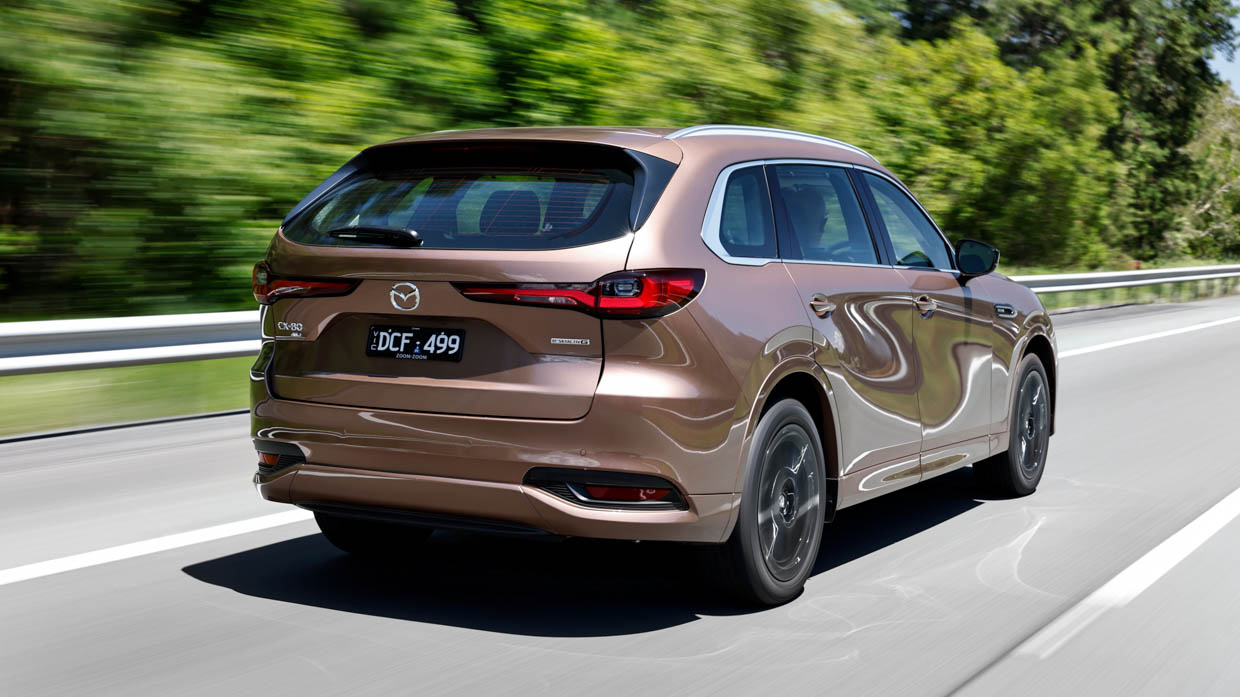
Another $7000 buys the GT, and here’s where the CX-80 really starts looking good. It rides on 20-inch black alloys and has body-coloured wheel arches and lower cladding – it’s a striking looking SUV like this, especially in new Melting Copper metallic paint, although perennial favourite Soul Red Crystal looks the business too.
GTs also get a panoramic sunroof, Bose audio, heated rear seats and pair of 12.3-inch screens covering infotainment and driver display.
Mystifyingly, Mazda persists with not allowing touchscreen operation while on the move by default, forcing you to scroll via a rotary dial. The smartphone mirroring experience is less useful and more distracting as a result though this can be changed in the settings.
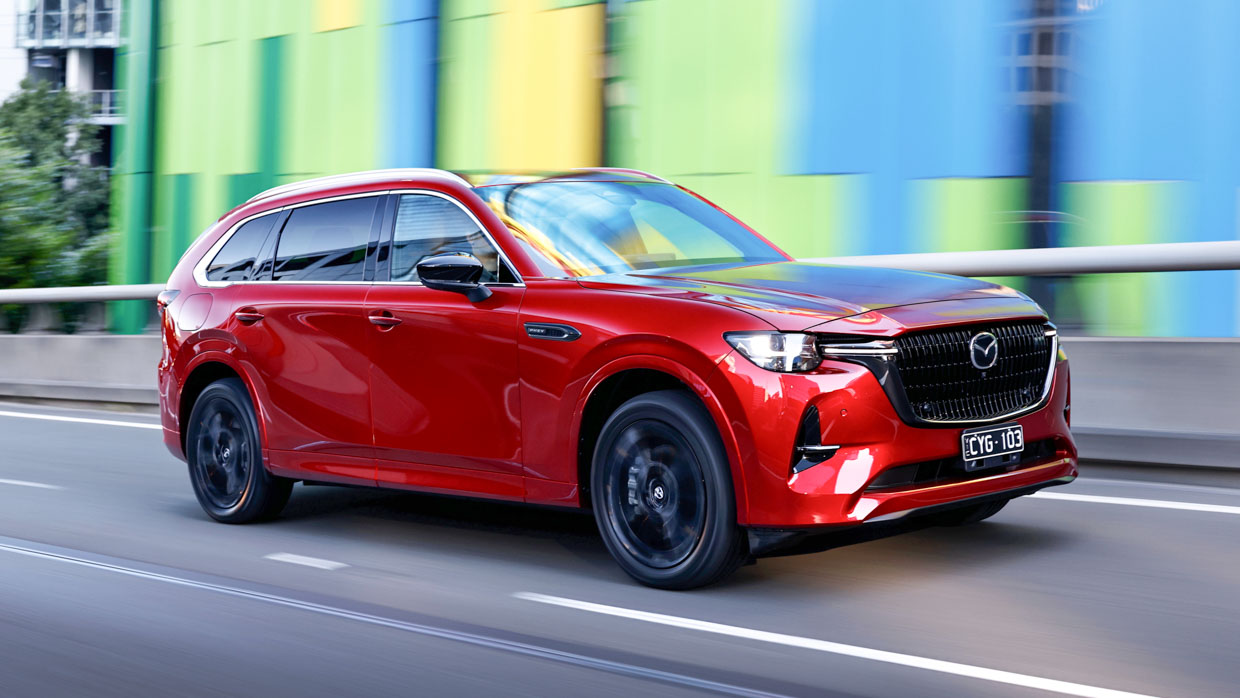
For luxe lovers, a $74,150 Azami grade rivals high-end Hyundais and Kias (superb cabins both), bringing black nappa leather ventilated seats, personalised driving position recognition and a see-through view for the 360-degree monitor.
Outside, 20-inch alloys are grey metallic and LED headlamps have a fancy signature.
You can drop another $5000 to get the SP option pack, available only on Azami. You’re now up for $80k before on-roads, but you’re in a special seven-seater. Nappa leather is now tan, as is the suede dashboard – just makes sure the kids don’t have grubby fingers.

The SP has black rims and gloss black body trim, but most interesting is it’s now a six-seater, as the second row scores ventilated captain’s seats. It feels more business class, although there are no arm rests for these chairs, nor can the centre console (with handy storage) be removed to create a walk-through.
Missed opportunity there, as is making six seats an option on lesser grades.
After a few hours in the saddle, kudos to Mazda for the cabin experience. In all grades it’s a well laid out, common sense dashboard with proper physical buttons rather than daft all-through-the-screen controls. Climate vitals are simple buttons and switches; driving position’s lofty with good visibility, and most plastic touchpoints are soft.


The centre console loses some premium points. The gear shifter is clunky to move into gear, the rotary dial feels lifted from Mazda’s entry-level SUVs, while arm rest storage is strangely shallow.
This at least allows for an individual digital climate control panel for the second row, and frankly, back here is where you want to ride. With three seats or two, head and leg room are superb, even with a panoramic roof.

Middle seats slide forward a long way for superb versatility, they have a nice recline and then tumble and fold for relatively easy third row access.
It’s excellent to see how most car brands now recognise these two back seats shouldn’t be mere afterthoughts, proven here with Mazda giving comfy seat bases, arm rests with cup holders, vents and USB-C ports.
As a six footer, the third row’s hardly stretch-out, but with second row seats slid forward a few inches, it’s perfectly humane. My head was just on the roof, and leg room fair. For kids, it’s absolutely ideal.
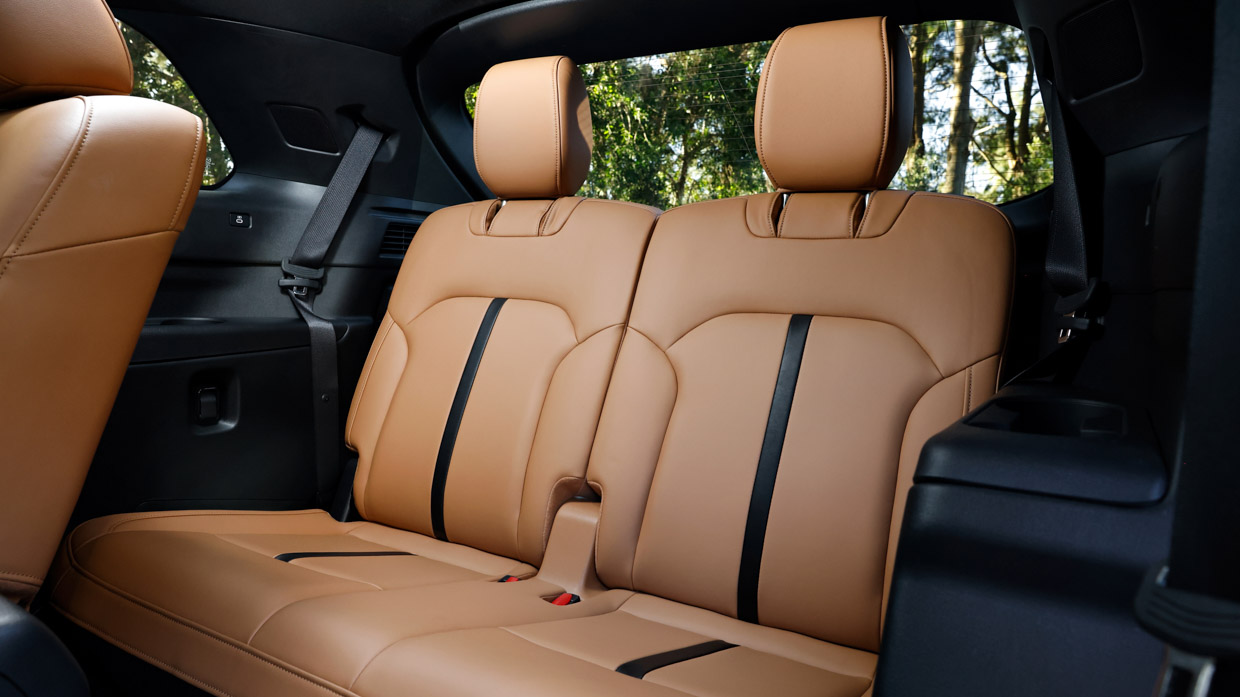
Mazda’s normally not the go-to for clever packaging with good boot space, but they’ve done well here.
Even with seven seats in place we’re promised a baby stroller or golf bag fits the 258L space. Five seats in place means a decent 566L with underfloor storage below, and with middle row down there’s an excellent 1971L. Sadly, just tyre repair kits range-wide.
Now, the drive experience. When I tested the smaller CX-60 and larger CX-90, both delivered drive experiences not up to Mazda’s typical high standards. Look to the CX-5 as proof Mazda knows exactly how to set up an SUV for superb balance of ride quality and handling. The recipe went a bit wrong with previous CX efforts.
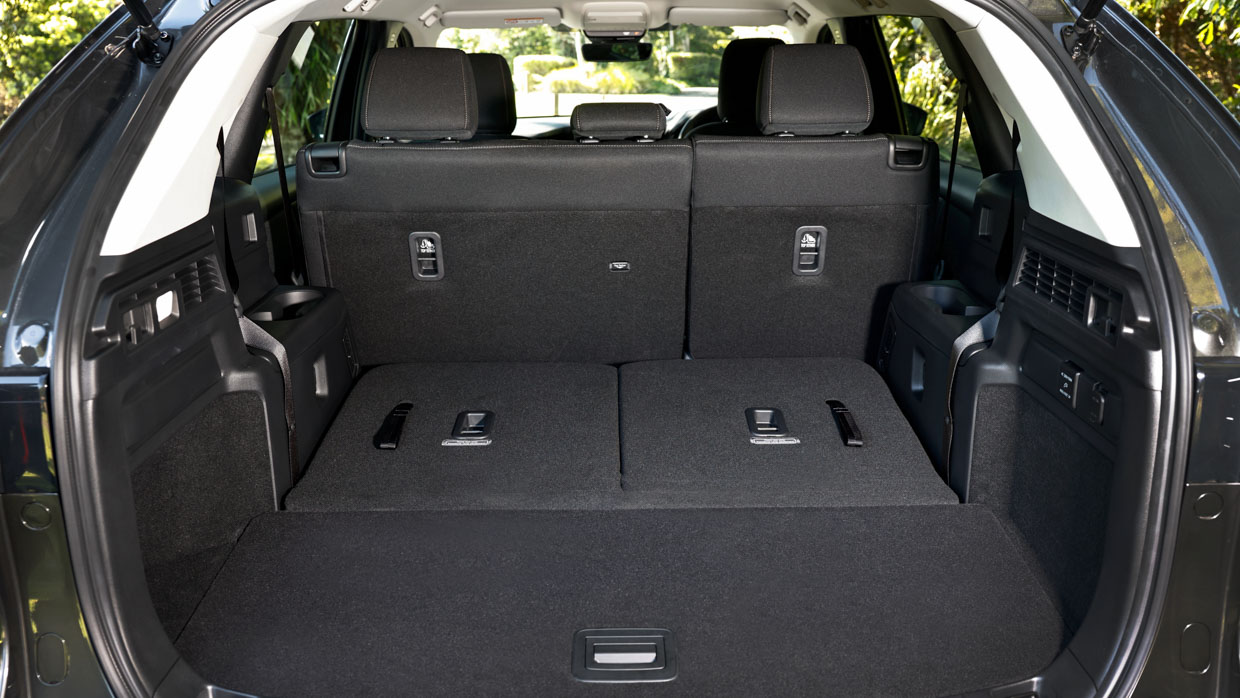

This CX-80 feels a better unit all round, but Mazda has once again delivered a large family SUV with suspension that feels overly firm. At low speeds on less than perfect roads (see every Australian city) it jars along, no matter if it’s on 18-inch or 20-inch wheels and rubber.
It’s not terrible, but personally I think such a car should be targeting pillowy ride quality, such as Toyota’s Kluger.
Trade-off is the CX-80 handles itself well in a corner. In fact, the more you push, the more this all-wheel-drive biggie with rear-drive bias impresses. Body roll is kept in reasonable check considering its size, and combined with gutsy engines, proves a fun big thing to punt along.

Road noise is well supressed, it’s a lush highway cruiser and blessedly the CX-80’s suite of safety systems aren’t overly nannying. Compared to the orchestra of chastising bongs found in the Santa Fe and Sorento, this Mazda saved its warnings for things closer to proper emergencies.
The useful stuff’s there like radar cruise control, advanced AEB, lane keep assist with emergency lane keep, blind spot monitor, safe exit warning, traffic sign recognition and front and rear cross traffic alert.
Perplexingly, our ride experience in the diesel CX-80 felt different to the petrol. The diesel seemed to handle road bumps better and give a more compliant ride. Its engineer assured me suspension changes between the two was minimal, but the difference was felt by both me and my passenger.
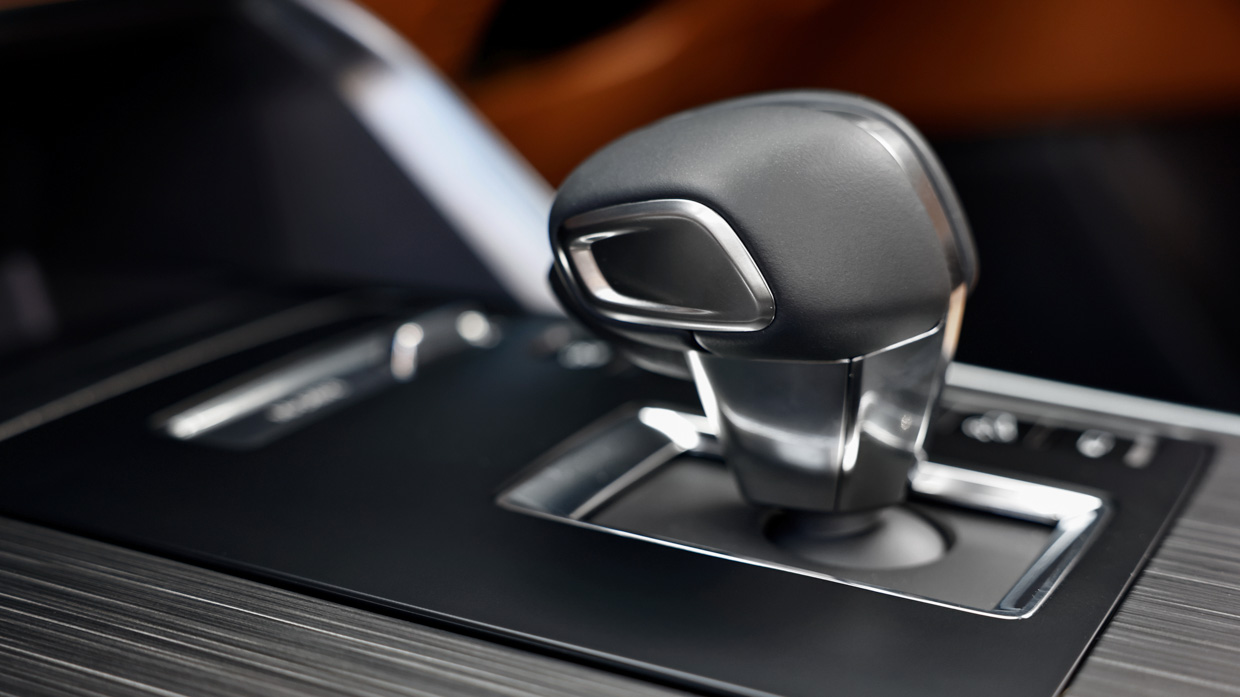
The diesel engine also brings a better all-round drive, and looks worth the extra $2000 over petrol grades. The petrol is a decent rig, but despite being a turbo straight-six, just lacks some of the diesel’s pure guts.
The oil burner has less power at 187kW, but 100Nm more torque with a chunky 550Nm. It’s smoother and torquier for daily driving, and barely sounds like a diesel at all.
The eight-speed auto gearboxes are better behaved than the ones in the CX-60 and CX-90, but were still prone to the odd bit of stage fright, especially when mated to the petrol engine. One minute it’s impressively smooth, the next a hesitation and little jerk, as if it’s got confused with the situation.
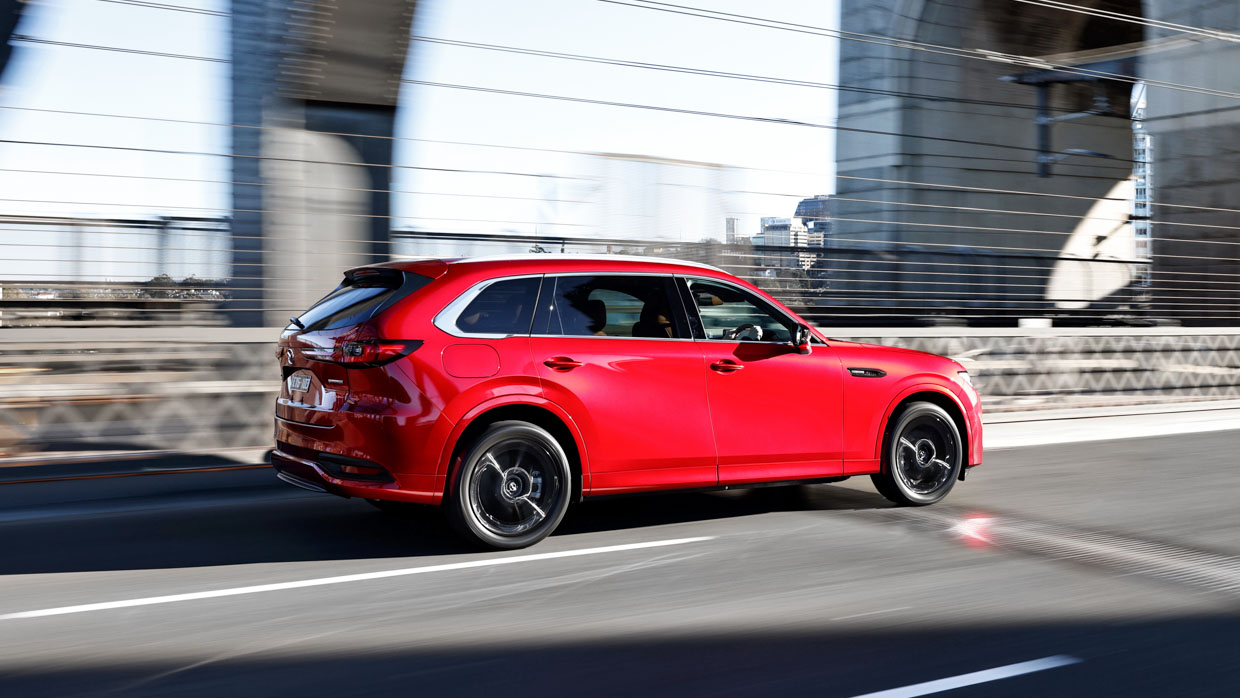
Economy? Mazda champions the CX-80 range as all-hybrid, but they’re simply using 48V mild hybrid tech.
You’ll barely notice it’s there, and the cars can’t run on electric-only power for short distances, as found in Toyotas, Hyundais and Kias. A shame, and no wonder people get confused about what ‘hybrid’ means on a car.
But economy bests Mazda’s old petrol and diesel four-cylinders, returning 8.4L/100km the petrol and 5.2L/100km the diesel. Our return wasn’t far off these figures, giving more sway towards going diesel. It’s a buttery-smooth straight-six with excellent low-down surge; it’s just a shame a Pure grade with diesel isn’t offered.
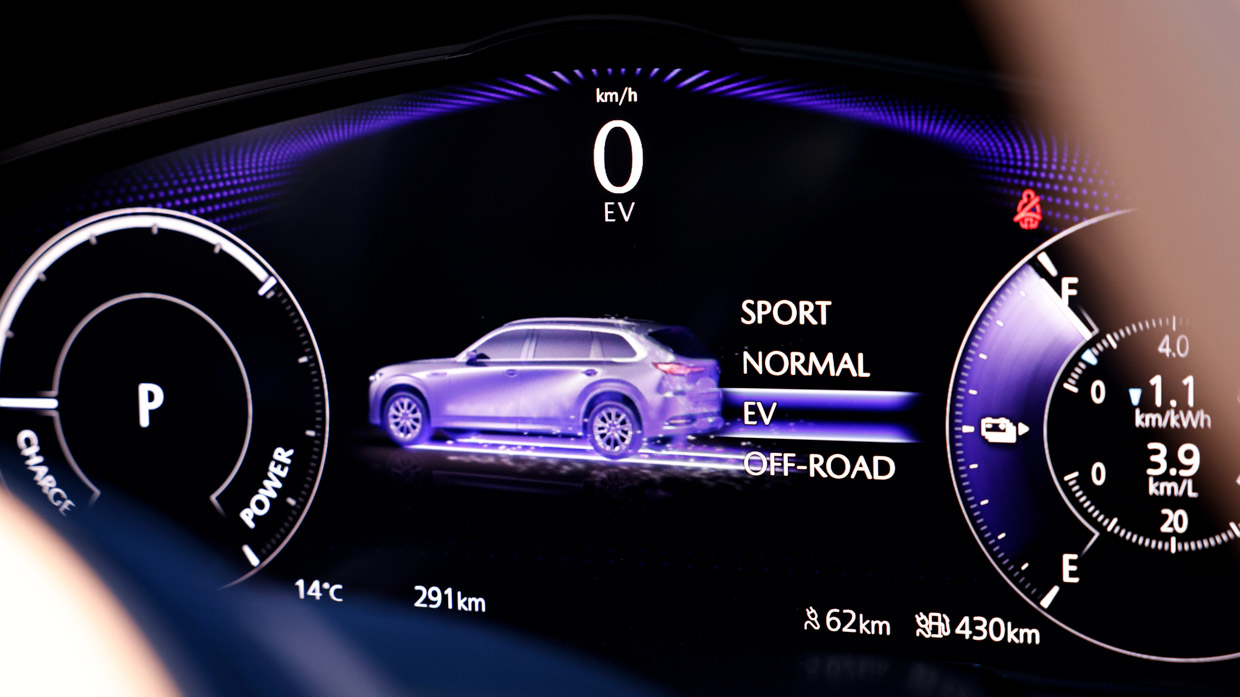
The plug-in hybrid version (PHEV) is going to be niche, not least when PHEV rebates expire next year. Its four-cylinder 2.5-litre petrol/electric combo is good for a chunky 241kW/500Nm, and there’s an impressive 65km electric-only range claim.
For those making regular short journeys it could be the pick, and certainly it’s got some shove with those motors in unison. It’s about 150kg heavier than the petrol or diesel, and feels it in corners. The PHEV’s gearbox, too, displayed first date jitters.
For PHEV positives, it’s the cheapest to service at $2623 for five years/75,000km, while the diesel is $3296 and petrol $3433. For comparison, Toyota charges just $1325 for five years servicing the Kluger hybrid. The PHEV and petrol both tow 2500kg, but the diesel only 2000kg. Tow ball download for all is only 150kg.
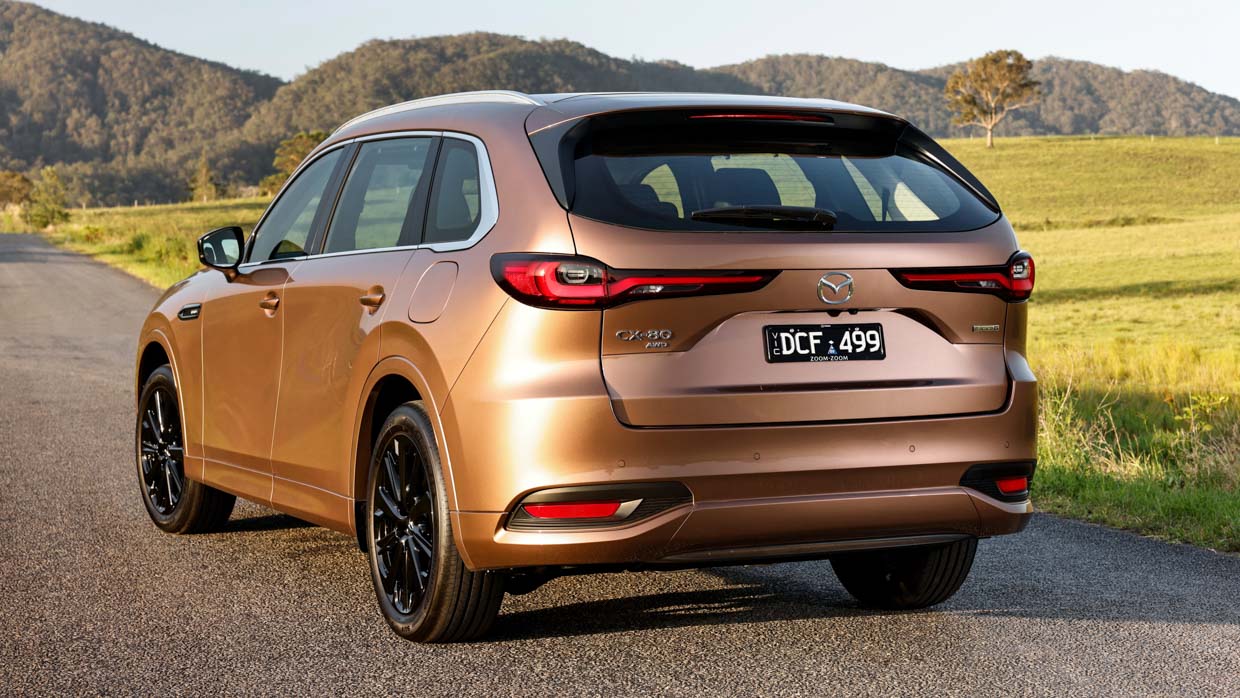
Mazda believes this CX-80 will be the volume seller in its large CX SUV range, and, well, of course it will. Heartland Mazda shoppers need a more affordable three-row large SUV, and it’s here in the CX-80 Pure, which is just a damn good family car for the roughly $59,800 drive-away asked.
The line-up is long and gets seriously luxurious (for a price), and the CX-80 is a welcome complement to the slightly bigger and fancier CX-90 seven-seater. Cabin space is excellent, controls are common sense and – a few stutters aside – the drive experience is well suited to Aussie family life.
It feels a truer replacement for the much-missed CX-8 and CX-9, and a sterner challenge to the quality-packed seven-seat SUV playground. Just good luck telling this new CX-80 apart from the rest of the range…
Key specs (as tested)
About Chasing cars
Chasing Cars reviews are 100% independent.
Because we are powered by Budget Direct Insurance, we don’t receive advertising or sales revenue from car manufacturers.
We’re truly independent – giving you Australia’s best car reviews.
The estimate provided does not take into account your personal circumstances but is intended to give a general indication of the cost of insurance, in order to obtain a complete quote, please visit www.budgetdirect.com.au. Estimate includes 15%^ online discount.
^Conditions Apply
Budget Direct Insurance arranged by Auto & General Services Pty Ltd ACN 003 617 909(AGS) AFSL 241 411, for and on behalf of the insurer, Auto & General Insurance Company Limited(ABN 42 111 586 353, AFSL 285 571).Because we don’t know your financial needs, we can’t advise you if this insurance will suit you. You should consider your needs and the Product Disclosure Statement before making a decision to buy insurance. Terms and conditions apply.
Indicative quote based on assumptions including postcode , 40 year old male with no offences, licence suspensions or claims in the last 5 years, a NCD Rating 1 and no younger drivers listed. White car, driven up to 10,000kms a year, unfinanced, with no modifications, factory options and/or non-standard accessories, private use only and garaged at night.
^Online Discounts Terms & Conditions
1. Discounts apply to the premium paid for a new Budget Direct Gold Comprehensive Car Insurance, Third Party Property Only or Third Party Property, Fire & Theft Insurance policy initiated online on or after 29 March 2017. Discounts do not apply to optional Roadside Assistance.
2. Discounts do not apply to any renewal offer of insurance.
3. Discounts only apply to the insurance portion of the premium. Discounts are applied before government charges, taxes, levies and fees, including instalment processing fees (as applicable). The full extent of discounts may therefore be impacted.
4. We reserve the right to change the offer without notice.